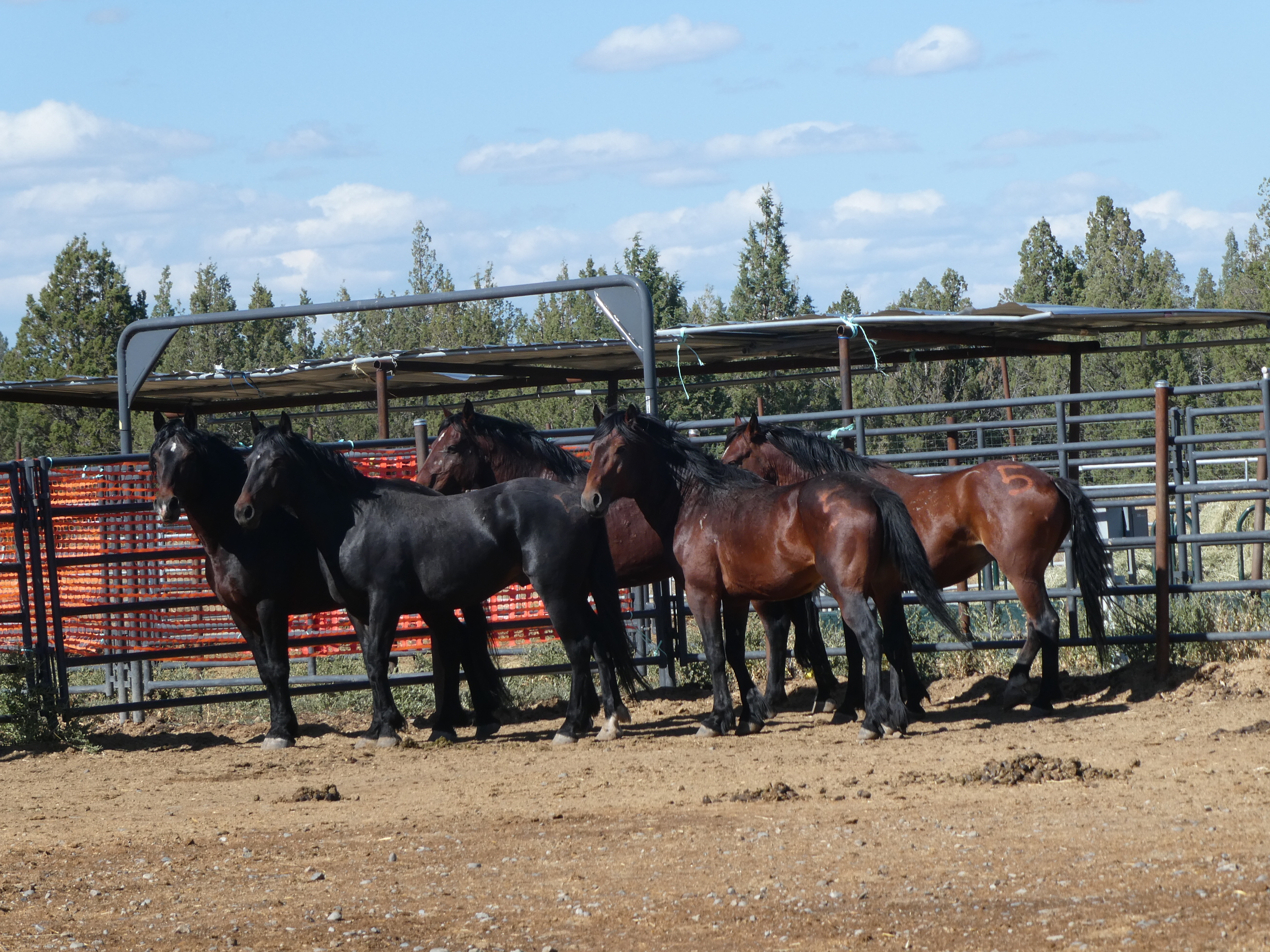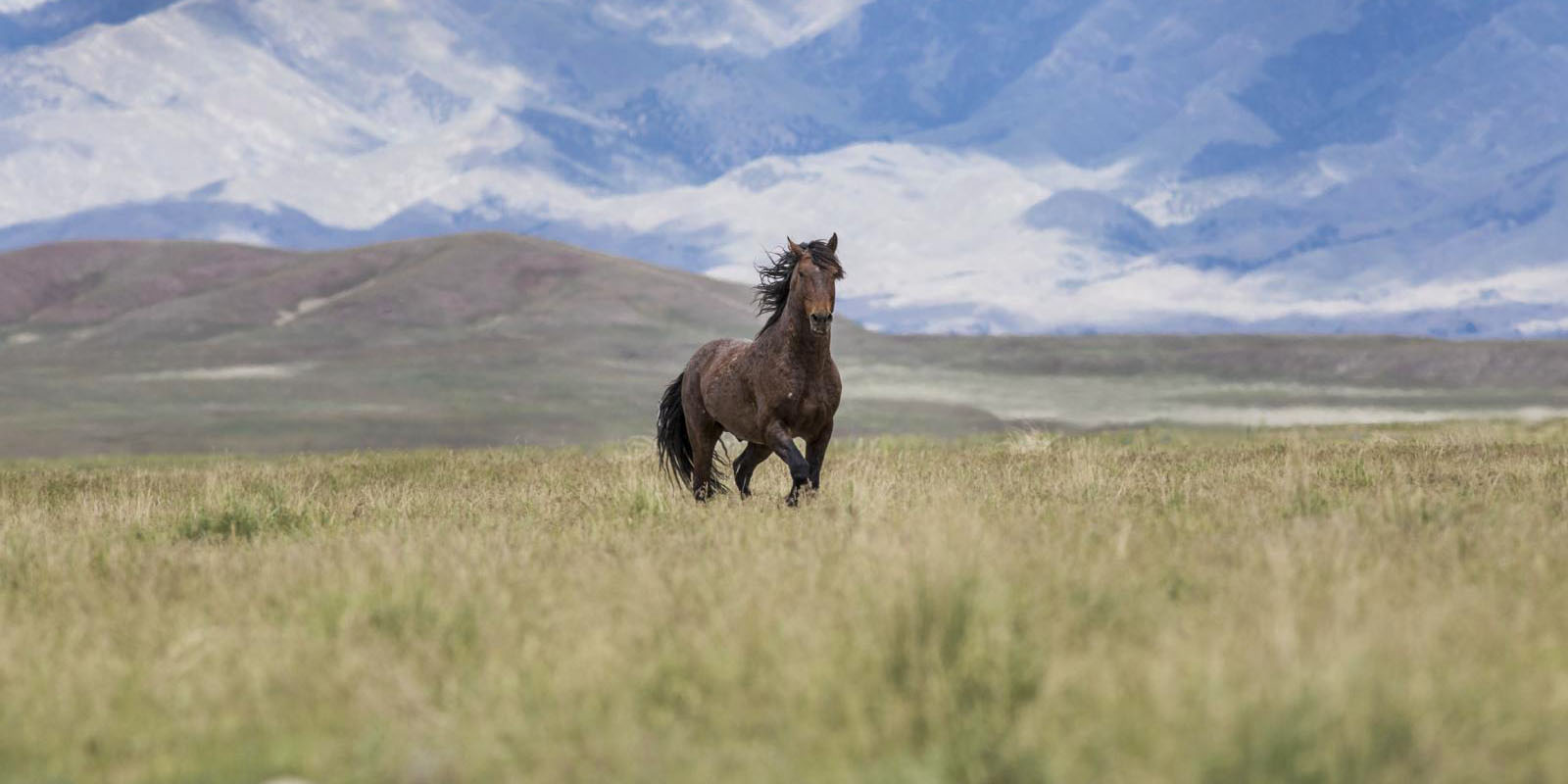On Wednesday, October 11 th , the United States Forest Service’s (USFS) roundup and removal of the Devil’s Garden wild horses in the Modoc National Forest (MNF) ended – the seventh in eight years. Although the USFS was targeting 500 horses on the Devil’s Garden Wild Horse Territory (Territory), this year the agency fell far short and removed less than half of its original goal via helicopter and bait trapping.
To AWHC’s knowledge, the USFS has yet to post a press release about the conclusion of the 37-day operation. That said, in response to our email, MNF staff did provide the following information:
Captured and Removed
- 210 adult horses were caught via helicopter trapping
- 8 adults were caught via bait trapping
- 18 foals were caught via helicopter trapping
- 2 mules were caught via helicopter trapping*
- *The two mules were known turnouts and were not born in the Territory.
TOTAL REMOVED: 236 WILD HORSES
Deaths and Injuries during Roundup and Removal
- 2 deaths – Both pre-existing and euthanized in the field. One was a filly with a broken right front leg, and the second an older gelding with a shoulder injury.
- 1 injury – A mare was injured from hitting a panel resulting in a protruding third eyelid. She was seen by a veterinarian and is recovering at the USFS Double Devil Wild Horse Corrals.
Between 2016 and 2023, the USFS has conducted seven roundups to reach the unscientific Appropriate Management Level (AML) of between 206 and 402 horses. With the 236 horses taken this year, the total number of wild horses removed from their federally-designated habitat is now 3,237.
At the same time, thousands of privately owned cattle and sheep are allowed to graze in the Territory.
In fact, when the trap site was located at Goose Lake during the first days of the operation, the helicopter stampeded several small bands of horses through a large herd of cows and their calves in order to run the former into the trap pen.
But such an imbalance is not unexpected given that the Modoc County Farm Bureau (MCFB) played such a key role in developing the 2013 Wild Horse Management Plan (WHMP) for the Territory that prioritized private livestock over what was once California’s largest wild horse herd. Just last year, the USFS posted a story celebrating the MNF and MCFB’s “fruitful year of shared stewardship” while “collaborating on projects of mutual interest” that included employing “A range specialist [who] assisted with wild horse management activities using the Wild Horse Territory Plan, which was developed previously by” the MFB and MNF.
Repeatedly, the USFS has stated that the massive roundups and removals are necessary to reduce the “overpopulation” of wild horses because it results in horses breaking through enclosure fencing “built to keep cattle from feeding on delicate riparian vegetation” and “affects all other uses, including rare and threatened native wildlife and the economy of Modoc County.”
But here’s a few thoughts to counter those justifications:
- Due to all the private livestock grazing allotments, the Territory contains an endless maze of fencing that makes it difficult for the wild horses to move freely across the Territory. If any horses do break through the enclosures, it could be because they need to in order to gain access to water sources.
From our observations, however, it seems that cattle themselves are the major violators.
- The roundups are supposed to help “the economy of Modoc County,” which means mostly ranchers who have grazing allotments in the Territory and who include a multimillion-dollar developer in San Jose, California. However, they’re easily costing the American public more than a million dollars each year. This year, for example, the USFS awarded Cattoor Livestock, Inc. a $650,000 contract for the helicopter and bait trap operation alone. This is in addition to the hundreds of thousands of dollars needed to pay USFS staff to help during the operations as well as care for the captured horses at the Double Devil Wild Horse Corrals. Then, of course, there are the costs for hay, vetting, and transportation of the horses and maintenance of the facility.
- The expensive and inhumane roundups are the only tool the USFS is using to reduce “overpopulation” of horses, but in recent years that’s not happening. According to this spring’s population census, there were 1,339 horses in the Territory; last spring, there were 1,205 horses. Therefore, despite removing 389 horses in last fall’s roundup, the number of horses increased by 134 horses between 2022 and 2023. If the USFS were truly interested in helping “rare and threatened native wildlife,” the agency should consider removing some of the fencing and reducing private livestock grazing in the Territory that costs only $1.35 per animal unit month.
Now, regarding the 236 horses who were removed versus the original goal of 500 horses, the MNF email states that “The horses that have not been gathered in the past are what have been left on the Devil's Garden Plateau and have become incredibly savvy. Additionally, the terrain, the trees, and the availability of water have made it difficult to gather horses in large numbers on the Devil's Garden Plateau.”
This is not the first time that the USFS has failed to reach its targeted number of horses for removal. In 2021, the agency rounded up 506 horses although its goal was 600 horses, and in 2022, 389 horses versus 500 horses.
It's certainly true that some horses have become “savvy.” Over the years, AWHC observers have witnessed stallions challenging the helicopter and bands of horses outmaneuvering it as they played cat and mouse in the forest at roundups. But that doesn’t account for the small number of horses caught in the bait traps. A more probable explanation is that there’s just not that many wild horses left in the Territory after seven years of unrelenting removals. As reported by AWHC observers at the roundups, while hundreds of cattle were visible every day, few to no wild horses who were not being chased by a helicopter were seen.
Also of concern is that of those 236 horses removed this year, only 18 were foals, meaning that the number of foals born is only 7.6% instead of the 20% that the USFS bases its estimated censuses on.
Finally, in September of 2022, the USFS issued a Scoping Notice for a Draft Environmental Assessment (EA) that would revise the 10-year-old WHMP. The agency was supposed to release the document in late summer. To date, it has not.
The EA includes an analysis of an unspecified fertility control program and the 23,000-acre Middle Section, which could increase the AML for wild horses in the Territory. The Middle Section was excluded in that 2013 WHMP – remember this is the document that was prepared by the MNF in partnership with the MCFB. In 2017, AWHC successfully sued to have the Middle Section reinstated as part of the Territory.
Devil’s Garden wild horses who were captured this fall will be available for sale or adoption at the Double Devel Wild Horse Corrals in Alturas, California beginning December 8th. Also, instead of euthanizing special needs horses like the Bureau of Land Management does, the MNF is looking for sanctuaries for these horses.
As of last month, about 70 Devil’s Garden horses remain from the 2022 roundup and removal as well as some from McGavin Peak, another USFS Territory in California. They, too, need placement. For more information about the horses, contact the Wild Horse Information Team at 530-233-8738 or [email protected]


